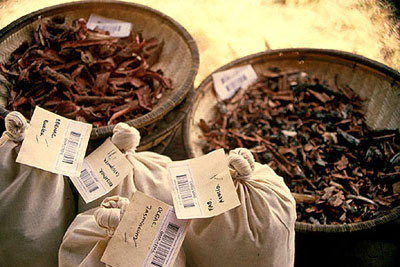 |
QUICK SEARCH
MO PROJECTS:
Africa
Asia/Pacific
Mesoamerica
North America
South America
General Taxonomy
Photo Essays
Training in Latin
America
MO RESEARCH:
Wm. L. Brown Center
Bryology
GIS
Graduate Studies
Research Experiences
for Undergraduates
Imaging Lab
Library
MBG Press
Publications
Climate Change
Catalog Fossil Plants
MO DATABASES:
W³MOST
Image Index
Rare Books
Angiosperm
Phylogeny
Res Botanica
All Databases
INFORMATION:
What's New?
People at MO
Visitor's Guide
Herbarium
Jobs & Fellowships
Symposium
Research Links
Site Map
Search
 |
table of contents |
 Plant material collected by Garden researchers in Tanzania for pharmaceutical screening by the National Cancer Institute. Photo: Heidi Schmidt |
|
|
(continued)
Many crop plants require occasional genetic infusions from closely related wild species to improve their nutritional value, disease resistance, and hardiness. As areas around the world are burned, cut, and plowed under, they take with them species whose uses may remain forever unexplored. Pharmaceutical, agricultural, and nutritional researchers cannot beat the clock alone. To know where to look and what to look for they need the skills and expertise that only botanists can provide. Since 1986, Garden scientists have collected and identified more than 35,000 plant samples, which are screened at other institutions and companies looking for chemical compounds that may lead to new products. Garden botanists collect in Africa and Madagascar for the National Cancer Institute, in Gabon for Sequoia Sciences, and in Suriname and Madagascar as part of an International Cooperative Biodiversity Group. All collecting by Garden scientists is carried out with respect and rigorous safeguards for the rights of host countries.* At the National Cancer Institute (NCI), scientists have discovered 13 promising chemical compounds from plants collected by Garden botanists. Most of these compounds are entirely new to science, and many have shown anti-HIV or anti-cancer activity in preliminary tests. Although modern mass-testing techniques have helped to expedite this work, it is still a slow and arduous process. At its foundation, it is made possible by the basic scientific activities - collecting, identifying and classifying plants - contributed by Garden botanists. From there, it is an uphill, scientifically rigorous climb from the initial collection site to a retail shelf, and few make it all the way. The timeline can span more than a decade. Dramatic results are the exception, rather than the rule. But this is a quest with phenomenal potential to promote the well-being of humankind. The outcomes will be worth the wait. And the Missouri Botanical Garden's special expertise will continue to play a central role in moving this effort forward. * The full text of MBG's Natural Products Research Policy can be seen at: www.mobot.org/MOBOT/research/applied_research/policy.html | |
| Text and photos from "The Unseen Garden" available from MBG Press. | |
© 1995-2025 Missouri Botanical Garden, All Rights Reserved
4344 Shaw Blvd.
St. Louis, MO 63110
(314) 577-5100
Technical Support